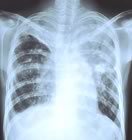|
Tuberculosis
 |
|
 |
 |
| |

Chest X-ray of severe pulmonary tuberculosis
patient
 |
|
Many people think that TB is a disease
of the past since a cure was developed 50 years ago. But TB never
went away in the UK and numbers have been rising since 1987. In
fact, TB is one of the top 3 killer diseases world-wide (along with
Malaria and HIV) killing 2 million people every year. One quarter
of all preventable deaths in adults under 65 are due to TB. In Asia
it costs an organisation like TB Alert just £25 to cure someone
of TB, and prevent them from spreading the disease to more than
10 other people each year.
The Symptoms
TB is caused by a bacterium. It may cause disease in any part of the body but
the lung is the usual site. A patient with TB of the lung will usually complain
of a cough. This may start as a dry irritating cough, which may be no different
from that suffered in any chest infection. The cough of TB will continue for
weeks or months getting progressively worse. After a while, profuse amounts
of phlegm may be brought up from the chest with each cough. If a blood vessel
is damaged blood may be coughed up.
Weight loss is also a common symptom, along with feeling generally unwell,
like a low-grade flu, which becomes gradually worse over weeks and months.
Temperatures which accompany the disease often occur at night causing the patient
to sweat profusely, so badly that it may be necessary to change all the bed
clothes in the middle of the night.
Sometimes the patient will complain of pains in the chest, which will be made
worse by coughing. In severe cases, breathlessness may occur. If you have any
of the symptoms listed, you do not necessarily have TB, but you should check
with your GP and ask to be tested.
The Diagnosis
TB of the lung usually causes characteristic changes on a Chest X-ray, which
will suggest but not confirm the disease. Once a chest x-ray has been taken
which may suggest that TB is present, the diagnosis should be confirmed by
obtaining phlegm for bacteriological analysis (called a ‘sputum test’).
The Treatment
Once TB is suspected treatment should be started. Patients will be given a
combination of antibiotics over a period of at least six months. If taken correctly,
patients will become non-infectious within a few weeks, but they must continue
the full treatment even after they feel better. Failing to complete the prescribed
treatment can result in the disease returning in a drug-resistant form, which
is much harder and more expensive to treat and cure.
The Family
TB is an infectious disease and is passed from one person to another by airborne
droplets spread as bacteria are coughed into the air by a patient just like
the common cold. TB is not usually as infectious as a cold but individuals
who are in close and frequent contact with a patient, such as family members,
may have acquired the disease. Special arrangements should be made to screen
the family by carrying out a chest x-ray and performing a skin test.
TB is a World Wide Problem
TB is increasing world wide, especially in poorer countries. Here a combination
of social deprivation and inadequate medical services has lead to a spread
of disease. The World Health Organisation estimate that 2 billion people, one
third of the world's population, are infected with the TB bacterium. About
one in ten of those infected will develop the disease. Each year there are
at least 8 million cases of TB of which 2 million die. It is estimated that
by the year 2050 there will be 5 million deaths a year from TB.
If you have any questions about TB or would
like to make a donation to support TB Alert call: 0845 456 0995
|



